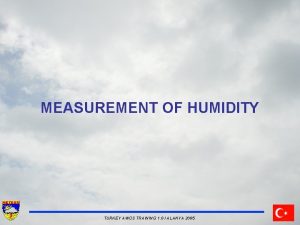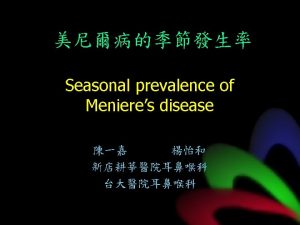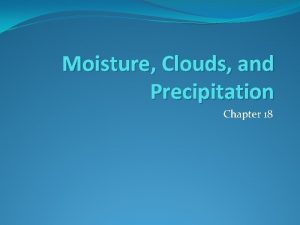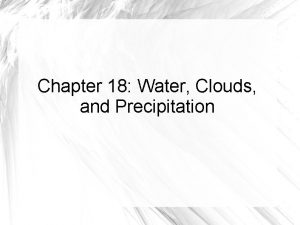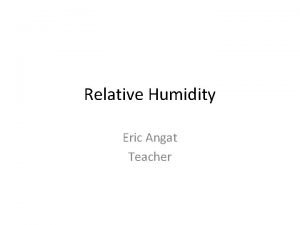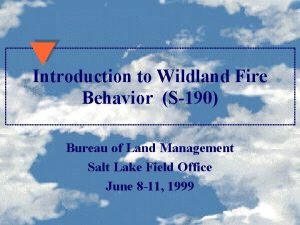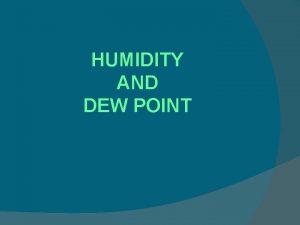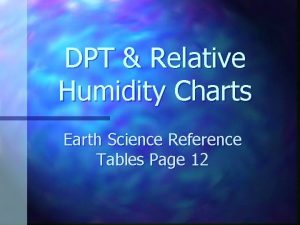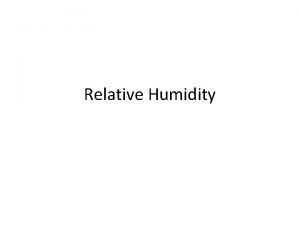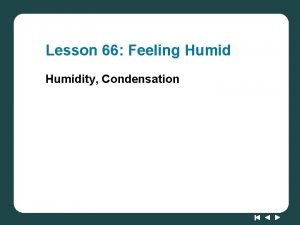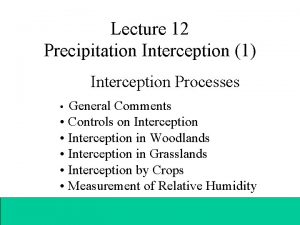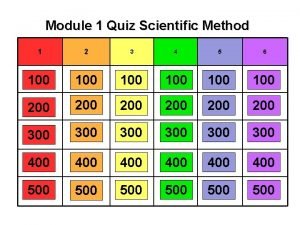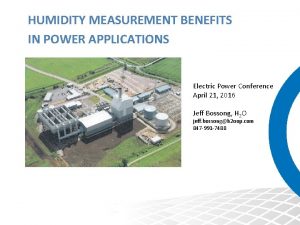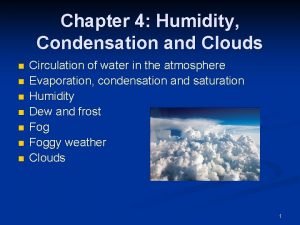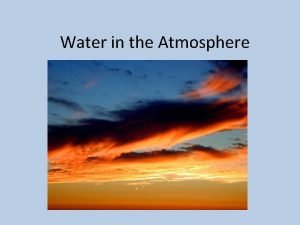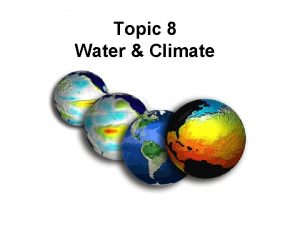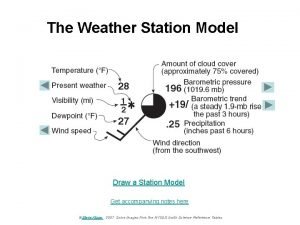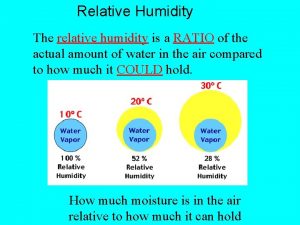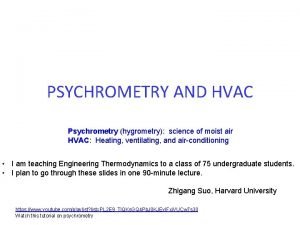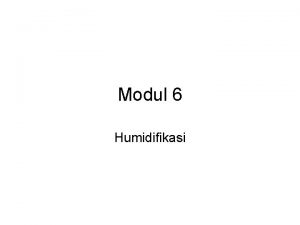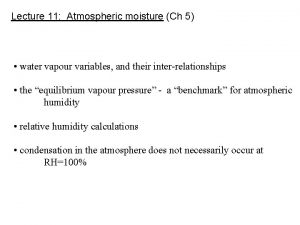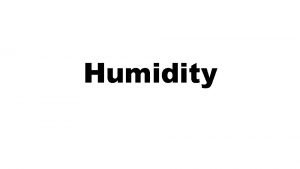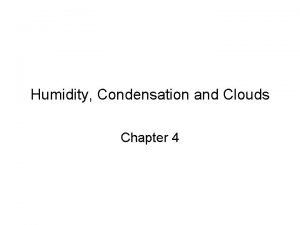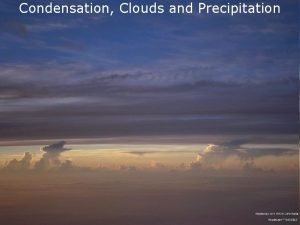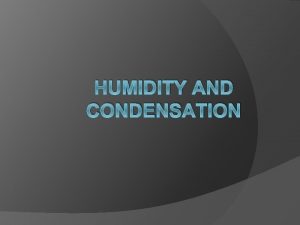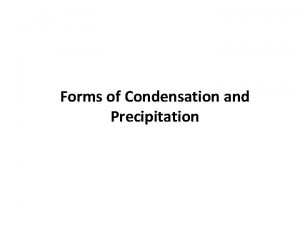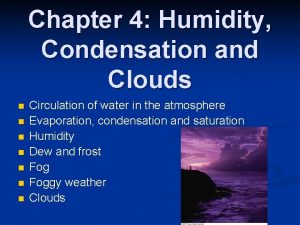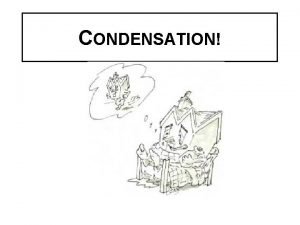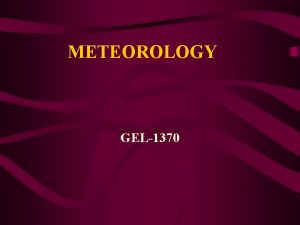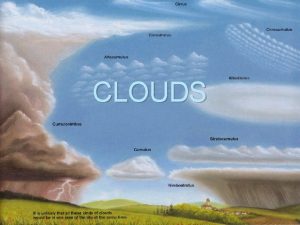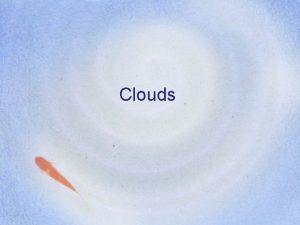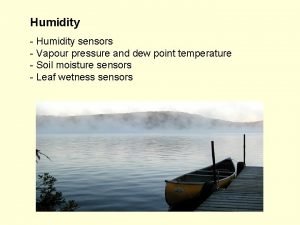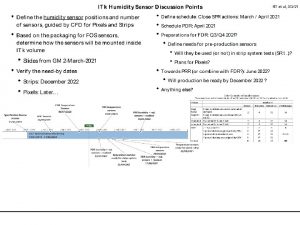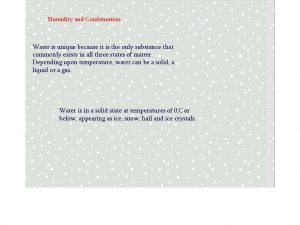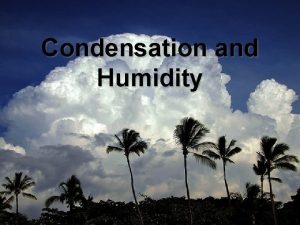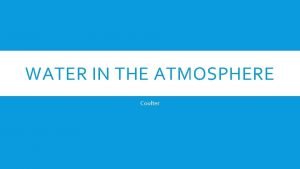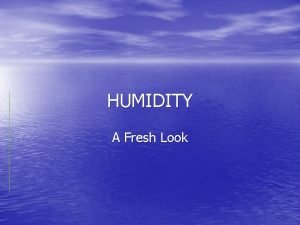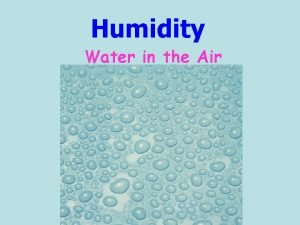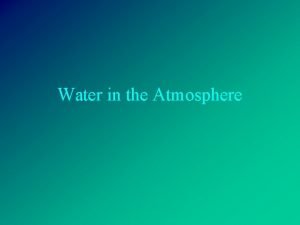Chapter 4 Humidity Condensation and Clouds n n




























- Slides: 28

Chapter 4: Humidity, Condensation and Clouds n n n n Circulation of water in the atmosphere Evaporation, condensation and saturation Humidity Dew and frost Foggy weather Clouds

Circulation of Water in the Atmosphere Hydrologic cycle evaporation and transpiration (from vegetation) condensation precipitation (rain, snow, hail) – when cloud droplets grow large enough to fall to surface runoff • The total amount of water vapor stored in the atmosphere amounts to only one week’s supply of precipitation for the planet. n Q 1: The earth’s hydrological cycle is exceedingly efficient in circulating water in the atmosphere. a) true; b) false

Fig. 4 -1, p. 80

Evaporation, Condensation and Saturation • Saturation: water molecules moving from liquid to vapor (evaporation) equal those moving from vapor to liquid (condensation) • Evaporation is increased by stronger wind; higher T Q 2: Water surface evaporation is stronger when air is a) moist; b) dry c) not too moist or dry

Evaporation, Condensation and Saturation n condensation needs condensation nuclei (microscopic bits of dust and salt from ocean spray) • In very clean air, about 10, 000 condensation nuclei are typically found in one cubic centimeter of air, a volume approximately the size of your fingertip. • Condensation occurs primarily when the air is cooled • Saturation is more likely to occur in cool air

Humidity describes the amount of water vapor in the air. • Water vapor density (absolute humidity): mv/V (kg/m 3) • Specific humidity mv/(mv+md) (kg/kg) • Mixing ratio: mv/md (kg/kg) • Vapor pressure: pv (mb) p = pv + pd • Relative humidity (%)

Vapor Pressure Saturated vapor pressure increases exponentially with T It is also provided in Table B. 1 on p. 440. T= 7 C, Pv = 10. 2 mb T =10 C, Pv = 12. 3 mb T =21 C, Pv = 25. 0 mb T = 24 C, Pv = 29. 6 mb Fig. 4 -5, p. 83

Relative Humidity n definition of relativ humidity: actual vapor pressure divided by saturation vapor pressure n n (RH = e/es * 100%) Supersaturation (RH > 100%) How to increase RH? Increase e decrease es (by decreasing T)

Fig. 4 -7, p. 85

Q 3: Which would decrease with the increase of T? a) water vapor density b) specific humidity c) mixing ratio Q 4: Which would decrease significantly with the increase of T? a) vapor pressure b) relative humidity Q 5: For water vapor in the hot, `dry’ air in the Sahara desert versus that in the cold, `damp’ polar air, which is true? a) the former is higher in mixing ratio, b) the former is higher in relative humidity

Relative Humidity and Dew Point n dew point temperature (Td) • It is the T to which air would have to be cooled (with no change in air pressure and moisture content) for saturation to occur • Higher Td indicates higher actual water vapor content • Actual vapor pressure = saturated pressure at Td n dew point depression (T – Td) and relative humidity Higher (T – Td) indicates lower RH

Ta = -2 C Td = -2 C Ta – Td = 0 C RH = 100% Ta = 35 C Td = 10 C Ta – Td = 25 C RH = 21% Fig. 4 -9 a, p. 87

Q 6: For Ta = 30 C, Td = 10 C, what is actual vapor pressure? a) 12 mb, b) 42 mb, c) 50 mb Q 7: For Ta = 30 C, Td = 10 C, what is RH? a) 12/42, b) 10/30, c) 50/86 Fig. 4 -5, p. 83

Relative Humidity and Human Discomfort n wet bulb temperature Tw: lowest T attained by evaporating water into the air; a good measure of how cool the skin can become Td: reached by cooling the air to saturation; a good measure of actual vapor content Graphically demonstrate Td < Tw < T Q 8: Under what conditions, Td = Tw = T? a) saturation, b) very dry, c) not too dry nor wet n Heat index Q 9: Why do both temperature and relative humidity contribute to warm-weather discomfort? A: higher RH; less body moisture evaporation; less cooling; feel warmer

Q 10: Which has a higher heat index? a) Ta = 100 F, RH = 20% (AZ), b) Ta = 95 F, RH = 40% (FL)

Measuring Humidity n Psychrometers Wet-bulb T (Tw); dry-bulb T (Ta); wet-bulb depression (Ta-Tw); Find Td and RH (based on Table D on p. 443 -446) for Ta = 20 C, Ta-Tw = 5 C: Td = 12 C, RH = 58% Ta = 90 F, Ta-Tw = 10 F: n Td = 76 F, RH = 65% Hygrometers hair hygrometer and electrical hygrometer: RH infrared hygrometer: moisture content; dew cell: vapor pressure dew-point hygrometer (for ASOS)

Dew and Frost dew: condensation at Td > 0 C (spherical beads of water) n frozen dew: dew forms and freezes (spherical beads) n frost: deposition (vapor to solid) at Tf < 0 C (tree-like branch) n freeze (black frost): Ta drops below 0 C without reaching Tf Q 11: `Freeze’ condition is colder than frost, because a) frost would release latent heat; b) `freeze’ condition would release latent heat n

Fog n n n radiation fog: cooling from ground advection fog: warm, moist air over cold surface upslope fog: cooling evaporation (mixing) fog: when moist air from your mouth or nose meets the cold air and mixes with it haze: hygroscopic (`water seeking’) condensation nuclei allows water vapor to condense when RH < 100%; haze has a better visibility than fog Q 12: The London fog is caused by a) radiation, b) advection, c) mixing

Foggy Weather n n n coastal or water body: radiation Interior: radiation and upslope hazard to aircraft: Some airports use fog-dispersal equipment Annual number of fog days

Classification of Clouds (chart at end of book) n major cloud types low, middle, high, vertical n cloud appearance sheetlike, puffy, wispy, rain cloud base 0 -2 Km, 2 -6 km, 6 -10 km • It’s easy to identify clouds, but it takes practice. The ability to identify clouds allows you to forecast many aspects of the weather using nothing but your eyes.

Table 4 -2, p. 98

High Clouds n n All high clouds: thin, high Cirrus (Ci): wispy Cirrocumulus (Cc): small, white puffs, rippling Cirrostratus (Cs): usually thin, often producing a halo

Middle Clouds All middle clouds: thicker than high clouds, cloud base > 2 km n Altocumulus (Ac): gray, puffy (larger, darker than Cc) n Altostratus (As): gray layer cloud with `watery sun’ (difference from Cs: darker, dimly visible, no ground shallows) n

Low Clouds All low clouds: base < 2 km, thicker than middle/high clouds n Nimbostratus (Ns) dark gray with light rain n Stratocumulus (Sc): larger cloud elements with lower cloud base than Ac n Stratus (St) uniform grayish cloud; has a more uniform base than Ns; has a lower base and dark gray than As; resembles a fog that does not reach the ground n

Clouds with Vertical Development Cumulus (Cu): puffy, floating `cotton’ with flat base n cumulus congestus (Tcu): line of towering Cu n Cumulonimbus (Cb): thunderstorm with anvils • Not all cumulus clouds grow to be thunderstorms, but all thunderstorms start out as cumulus clouds. n

Fig. 4 -32, p. 104

Some Unusual Clouds lenticular clouds: lens-like; UFO n Pileus: `cap’ n Mammatus clouds: baglike n Contrails: condensation trail from engine exhaust n

Q 13: This is: a) Cc, b) Ac, c) Sc, d) Cu Q 14: This is: a) Cs, b) As, c) St, d) Ns Q 15: This is: a) Cu, b) Tcu, c) Cb
 Temperature and humidity monitor turkey
Temperature and humidity monitor turkey Humidity and meniere's disease
Humidity and meniere's disease A picture of precipitation
A picture of precipitation Frontal wedging
Frontal wedging Dew point chart
Dew point chart Humidity comfort zone
Humidity comfort zone Identify three effects of low humidity s190
Identify three effects of low humidity s190 High humidity meaning
High humidity meaning Relative humidity reference table
Relative humidity reference table Outlook temperature humidity wind play
Outlook temperature humidity wind play What is humidity
What is humidity What is humidity
What is humidity Calculate relative humidity
Calculate relative humidity What single factor controls humidity
What single factor controls humidity Three redwood trees are kept at different humidity levels
Three redwood trees are kept at different humidity levels Humidity 2 optimization
Humidity 2 optimization Relativ humidity
Relativ humidity Relative humidity chart
Relative humidity chart Mountain humidity
Mountain humidity Barometric trend station model
Barometric trend station model Relative humidity
Relative humidity Absolute humidity
Absolute humidity Contoh soal humidity
Contoh soal humidity How to calculate vapor pressure of water
How to calculate vapor pressure of water Humidity
Humidity Which statement accurately describes humidity?
Which statement accurately describes humidity? Relative humidity station model
Relative humidity station model Which definition best describes global warming?
Which definition best describes global warming? Webalarm
Webalarm
